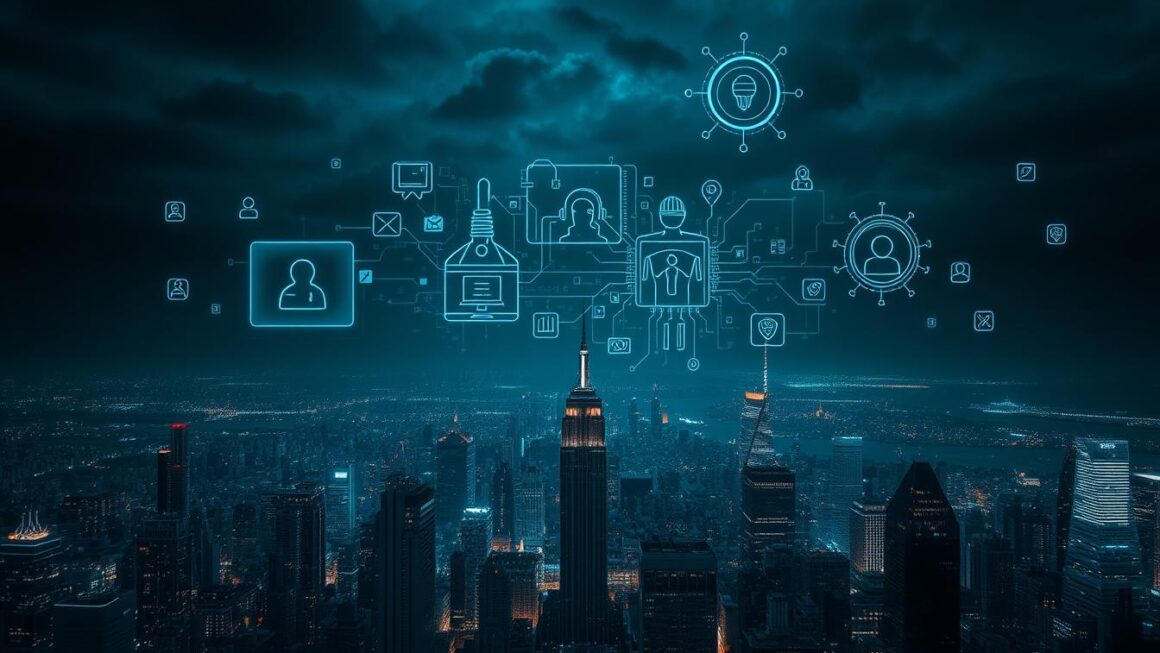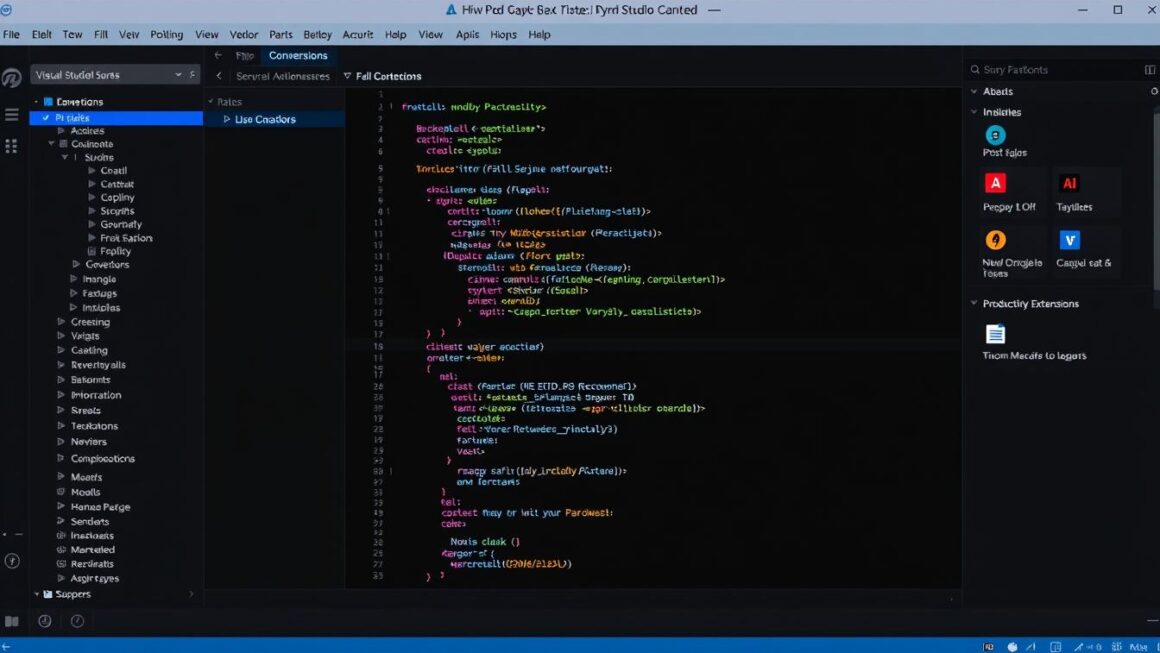As we get closer to 2025, the world of cybersecurity is getting more complex. New threats like advanced ransomware and AI-powered cybercrime are coming. These need us to take action and be ready.
We’re seeing more AI-Powered Phishing and Ransomware-as-a-Service. It’s very important to know about these threats. This way, we can create strong defense plans.
By keeping up with cybersecurity trends, we can fight these new dangers. This helps protect our organizations.
Key Takeaways
- Emerging cyber threats require proactive security measures.
- AI-Powered Phishing and Ransomware-as-a-Service are on the rise.
- Understanding cybersecurity trends is key for defense.
- Staying informed helps organizations protect themselves.
- Effective defense strategies are vital to fight cyber threats.
The Evolving Cyber Threat Landscape of 2025
As we enter 2025, the cyber threat scene is changing fast. Cyber attacks are happening more often and getting smarter. This makes it tough for companies all over the world.
How Threats Have Evolved
In 2023, ransomware was the top cyber attack, making up about 70% of all attacks. But in 2025, new threats like AI-powered phishing and deepfake attacks are rising. These threats are harder to spot because they’re more advanced.
- Increased Sophistication: Cyber attacks are getting more complex. They use AI and machine learning to get past old security methods.
- Diverse Attack Vectors: Attackers are using many ways to get in, from IoT devices to cloud mistakes.
Why Our Organizations Need New Defense Strategies
With threats changing, our companies must find new ways to defend themselves. This means using advanced threat detection, doing security checks often, and making security a top priority.
- Teaching employees to spot and handle smart phishing tricks.
- Setting up strong security layers to fight off different attacks.
- Keeping an eye on and updating our security plans to face new dangers.
AI-Powered Phishing: The New Face of Social Engineering
In 2025, we face a new threat in cybersecurity: AI-powered phishing. This threat uses artificial intelligence to create attacks that are very convincing and tailored to each victim. This makes them harder to spot.
How AI Makes Phishing More Dangerous
AI makes phishing attacks more dangerous in several ways. It uses machine learning for message personalization and voice and visual cloning techniques.
Machine Learning and Message Personalization
Attackers use machine learning to study their targets. They then create messages that are very likely to fool people.
Voice and Visual Cloning Techniques
AI can make voices and visuals look like real people. This makes phishing attacks seem even more real.
Case Studies: Recent AI Phishing Breaches
Recent attacks show how bad AI phishing can be. For example, a big bank was hit by a phishing scam. It used the CEO’s voice to trick people into doing something wrong.
Our Defense Playbook: Filters, Training, and MFA
To fight AI phishing, we use a few key steps. First, we have email filters to catch and stop phishing. We also do regular employee training to teach people about AI phishing. And we use multi-factor authentication (MFA) to make our systems safer.
By using these methods together, we get better at keeping our systems safe. This helps us fight the new threats of 2025, like AI phishing.
Ransomware-as-a-Service: Democratized Digital Extortion
Ransomware-as-a-Service is changing the cybercrime world. It makes it simple for bad actors to launch complex attacks. They don’t need to be tech experts anymore.
The RaaS Business Model Explained
The RaaS model works like any other software service. Attackers just need to subscribe to ransomware kits. This has led to more ransomware attacks on businesses of all sizes.
Case Studies: Small Businesses Targeted by RaaS
Small businesses are easy targets because they often lack strong security. For example, a small retail store might get hit by RaaS. Attackers then ask for ransom to get back the data.
Building Our Multi-Layered Ransomware Defense
To fight RaaS, we use a strong defense plan. This includes:
- Backup Strategies That Actually Work: We make regular backups. This way, we can quickly get back data if attacked.
- Endpoint Protection: We use top-notch tools to stop ransomware before it starts.
- Employee Training: We teach our team how to avoid getting infected in the first place.
Backup Strategies That Actually Work
Good backup plans mean regular, automated backups in safe places. This lets us quickly get back data if hit by ransomware.
Endpoint Protection and Employee Training
Combining strong endpoint protection with employee training lowers our risk. Our team knows how to spot phishing and other threats.
By using these cyber resilience techniques and keeping up with new cybersecurity measures, we can beat Ransomware-as-a-Service.
Supply Chain Attacks: Exploiting the Weakest Links

Supply chain attacks are getting more complex. They target the weakest spots in our digital world. Cybercriminals use third-party vendors to get into big organizations. They do this by taking advantage of the trust and access given to these outside groups.
Targeting Software Dependencies
Attackers often go after software dependencies to sneak into systems. By hacking a trusted software piece, they can hit many places with one attack.
Key vulnerabilities include:
- Outdated software components
- Insecure coding practices
- Lack of thorough vetting of third-party vendors
Case Studies: When Trusted Vendors Become Threat Vectors
Many big breaches have happened because of supply chain attacks. For example, the SolarWinds incident in 2020 hit many government and private groups. It did this by targeting a trusted software vendor.
These cases show we need robust cyber threat intelligence and strong defense plans.
Securing Our Supply Chain Effectively
To fight supply chain risks, we must check our suppliers and partners well. Using Software Bills of Materials (SBOM) helps spot weak spots.
Implementing Software Bills of Materials (SBOM)
An SBOM lists all software parts in an app. It helps us keep track of and fix software chain vulnerabilities.
Vendor Security Assessment Frameworks
We should also use vendor security check-ups. This means looking at their security steps, how they handle incidents, and if they follow industry rules.
By using these best defense strategies for cyber threats, we can better protect ourselves against supply chain attacks. This keeps our digital world safe.
Deepfake and Synthetic Media: When Seeing Isn’t Believing
In 2025, we face a big threat in the cyber world. Deepfake and synthetic media are fake videos, voice messages, and images made by AI. They look very real and are hard to spot.
The Technology Behind Convincing Deepfakes
Deepfakes use AI to make fake content that looks real. This tech has gotten better fast. Now, even people who aren’t tech-savvy can make fake videos that seem real.
Case Studies: Business Fraud Through Synthetic Media
Deepfakes have caused big problems in business. For example, a CEO lost money because of a deepfake video call from someone who looked like a colleague. This shows we need to be careful and check things before we believe them.
Detecting and Defending Against Deepfake Attacks
To fight deepfake attacks, we need to do several things. This includes:
- Using technology to check if media is real.
- Teaching employees how to spot deepfakes.
Media Verification Protocols
Checking media for realness is key. We can use digital watermarks and forensic analysis to find out if something has been tampered with.
Employee Training for Deepfake Awareness
It’s important to teach employees about deepfakes. They should learn how to spot them and what to do if they find one.
By using these methods, we can better protect ourselves from deepfake threats. This will help keep our organizations safe from these advanced cyber attacks.
IoT Vulnerabilities: The Expanding Attack Surface
The rise in IoT devices is making our lives more connected. But it also brings new cybersecurity risks. As we add more smart devices, the chance of cyber attacks grows.
Common Security Flaws in Smart Devices
IoT devices often have weak passwords and outdated software. They also lack strong encryption. These issues make it simple for hackers to get into our systems.
Case Studies: When Smart Devices Create Dumb Security
There have been many times when IoT devices were hacked. For example, the Mirai botnet attack in 2016 used default passwords. It caused big problems with internet services.
Best Practices for Securing Our IoT Ecosystems
To fight IoT threats, we need a strong plan. We should change default passwords and keep devices on separate networks. Also, we must update their software regularly.
Network Segmentation Strategies
Breaking our networks into segments helps a lot. It keeps IoT devices away from important parts of our systems. This way, if a device gets hacked, the damage is less.
Firmware Management and Updates
Keeping IoT device software up to date is key. It fixes known problems. A good system for managing updates keeps our devices safe from new threats.
By using cyber resilience techniques and staying alert, we can keep our IoT systems safe. This is important as cyber threats keep changing.
Cloud Misconfigurations: The Silent Data Exposer
Cloud misconfigurations are a big problem in today’s digital world. We use cloud services a lot for data storage and processing. But, setting up these services wrong can be risky.
Why Cloud Security Remains Challenging
Keeping cloud services safe is hard because they are complex. Effective cybersecurity solutions for 2025 threats need to understand these complexities well.
Case Studies: Major Breaches from Minor Misconfigurations
Many big data breaches happened because of small mistakes in cloud settings. For example, wrong settings in storage buckets have leaked sensitive data. This shows we need robust cyber threat intelligence in 2025.
Tools and Techniques for Secure Cloud Deployment
To avoid cloud misconfigurations, we can use different tools and methods. These include:
- Cloud Security Posture Management (CSPM) tools to watch and fix misconfigurations.
- Access control best practices to stop unauthorized access.
Cloud Security Posture Management (CSPM) Implementation
Using CSPM means always checking cloud resources for wrong settings. This is key for cybersecurity solutions for 2025 threats.
Access Control Best Practices
Following access control best practices is vital for cloud safety. Practices like the least privilege principle and multi-factor authentication help a lot. By using these, we can lower the risk of cloud misconfigurations and improve our cyber threat intelligence in 2025.
2025’s Top Cyber Threats and How to Defend Against Them: A Complete Strategy

In 2025, defending against cyber threats needs a detailed plan. The threats keep changing, so we must stay ahead. We need to be quick and flexible in our defense.
Integrating Our Defense Mechanisms Across Threat Vectors
It’s important to link our defenses across different threats. We should have a single security plan that covers AI-powered phishing, ransomware-as-a-service, supply chain attacks, and more. This makes our defenses strong and hard to get past.
To link our defenses, we use artificial intelligence and machine learning. These tools help us spot and fight threats better. We also need a zero-trust security model. It checks who gets to see or use our important data and systems.
Building a Security-First Organizational Culture
Creating a culture that puts security first is key. We need to make sure everyone knows how to help keep our data safe. This means teaching them about security and encouraging them to report any odd stuff.
- Regular security training and awareness programs
- Encouraging a culture of reporting suspicious activities
- Incentivizing security best practices
By linking our defenses and building a security-focused culture, we can better fight cyber threats in 2025. This way, we can keep our organization’s data safe and stay ahead of new threats.
Measuring Security Effectiveness Against Emerging Threats
In 2025, keeping our cybersecurity strong is key. We must know the latest threats and use top-notch security tools. This helps us stay one step ahead.
To measure our security well, we focus on important areas. These give us clues about how strong our defenses are.
Key Performance Indicators for Our Cyber Defense
We track certain Key Performance Indicators (KPIs) to see how good our defense is. We look at mean time to detect (MTTD) and mean time to respond (MTTR) to attacks. We also check how often we do security checks and if employees get regular training.
By watching these KPIs, we find out where we can get better at cyber resilience techniques.
Continuous Testing and Improvement Methodologies
Testing our security all the time is essential. We use red teaming and penetration testing to mimic real attacks. This helps us find weak spots.
We also use continuous integration and continuous deployment (CI/CD) to keep our security up to date. This way, we can always be ready for new threats and improve our cybersecurity measures for future threats.
By always checking our security and improving, we get better at fighting off new threats.
Real-World Success: How Three Companies Thwarted Advanced Attacks
In 2025, the world of cybersecurity is very complex. It’s important to look at companies that have fought off advanced cyber threats. By studying their success, we can learn how to protect ourselves better.
Financial Sector: Stopping a Multi-Vector Attack
A top financial company in the U.S. stopped a multi-vector attack. They used advanced threat detection, regular security checks, and trained their employees. Thanks to these steps, they stopped the threat early and kept their customers’ data safe.
Healthcare: Defending Against Ransomware
A healthcare group faced a ransomware attack but won. They used a strong defense plan. This included keeping backups up to date, using anti-ransomware tools, and training staff. Their efforts kept care going and saved data, showing how to fight cyber attacks.
Manufacturing: Securing the Supply Chain
A manufacturing company made its supply chain safe. They checked risks, set strict security rules, and watched for odd activity. This approach greatly lowered the chance of a breach, showing a good way to handle complex threats.
Conclusion: Staying Ahead in the Cyber Arms Race
As we near 2025, the world of cyber threats is getting more complex. We’ve looked at major threats like AI-powered phishing and Ransomware-as-a-Service. We’ve also talked about supply chain attacks, deepfakes, IoT vulnerabilities, and cloud misconfigurations.
To fight these threats, companies need to be proactive and flexible. Our plan includes using defense strategies across different areas, building a culture that values security, and checking how well our security works. By knowing about these threats and how to stop them, we can lead in the cyber race.
Success comes from being alert, working together, and always improving in cybersecurity. This way, we can handle the changing cyber world of 2025 and keep our organizations safe from new dangers.



